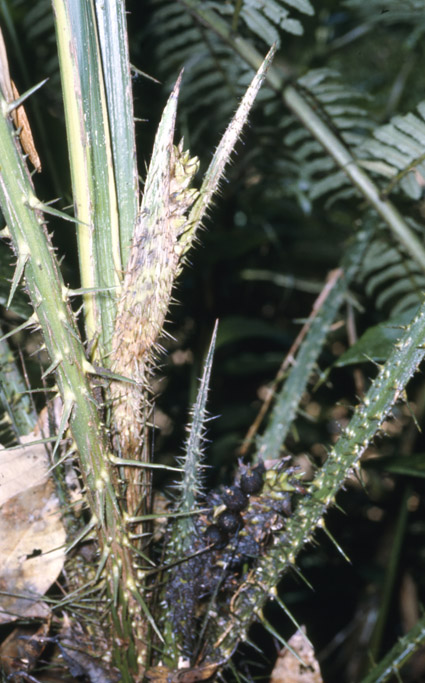- Acanthophoenix
- Acrocomia
- Actinokentia
- Actinorhytis
- Adonidia
- Aiphanes
- Allagoptera
- Ammandra
- Aphandra
- Archontophoenix
- Areca
- Arenga
- Asterogyne
- Astrocaryum
- Attalea
- Bactris
- Balaka
- Barcella
- Basselinia
- Beccariophoenix
- Bismarckia
- Borassodendron
- Borassus
- Brassiophoenix
- Burretiokentia
- Butia
- Calyptrocalyx
- Calyptrogyne
- Calyptronoma
- Carpentaria
- Carpoxylon
- Caryota
- Ceratolobus
- Ceroxylon
- Chamaedorea
- Chamaerops
- Chambeyronia
- Chelyocarpus
- Chuniophoenix
- Clinosperma
- Coccothrinax
- Cocos
- Corypha
- Cryosophila
- Cyphokentia
- Cyphophoenix
- Cyphosperma
- Daemonorops
- Deckenia
- Desmoncus
- Dictyocaryum
- Drymophloeus
- Dypsis
- Elaeis
- Eleiodoxa
- Eremospatha
- Eugeissona
- Euterpe
- Gaussia
- Geonoma
- Guihaia
- Hedyscepe
- Hemithrinax
- Howea
- Hyophorbe
- Hyospathe
- Hyphaene
- Iriartea
- Iriartella
- Itaya
- Jailoloa
- Johannesteijsmannia
- Juania
- Jubaea
- Jubaeopsis
- Kentiopsis
- Kerriodoxa
- Korthalsia
- Laccospadix
- Laccosperma
- Lanonia
- Latania
- Lemurophoenix
- Leopoldinia
- Lepidocaryum
- Lepidorrhachis
- Leucothrinax
- Licuala
- Linospadix
- Livistona
- Lodoicea
- Lytocaryum
- Manicaria
- Manjekia
- Marojejya
- Masoala
- Mauritia
- Mauritiella
- Maxburretia
- Medemia
- Metroxylon
- Myrialepis
- Nannorrhops
- Nenga
- Neonicholsonia
- Neoveitchia
- Nephrosperma
- Normanbya
- Nypa
- Oenocarpus
- Oncocalamus
- Oncosperma
- Orania
- Oraniopsis
- Parajubaea
- Pelagodoxa
- Phoenicophorium
- Phoenix
- Pholidocarpus
- Pholidostachys
- Physokentia
- Phytelephas
- Pigafetta
- Pinanga
- Plectocomia
- Plectocomiopsis
- Podococcus
- Pogonotium
- Ponapea
- Prestoea
- Pseudophoenix
- Ptychococcus
- Ptychosperma
- Raphia
- Ravenea
- Reinhardtia
- Retispatha
- Rhapidophyllum
- Rhapis
- Rhopalostylis
- Roscheria
- Roystonea
- Sabal
- Sabinaria
- Salacca
- Saribus
- Satakentia
- Satranala
- Schippia
- Sclerosperma
- Socratea
- Solfia
- Sommieria
- Syagrus
- Synechanthus
- Tahina
- Tectiphiala
- Thrinax
- Trachycarpus
- Trithrinax
- Veitchia
- Verschaffeltia
- Voanioala
- Wallaceodoxa
- Wallichia
- Welfia
- Wendlandiella
- Wettinia
- Wodyetia
- Zombia
- x Jubautia splendens
- ?? Acoelorrhaphe
- ?? Bentinckia
- ?? Brahea
- ?? Clinostigma
- ?? Colpothrinax
- ?? Copernicia
- ?? Cyrtostachys
- ?? Dictyosperma
- ?? Dransfieldia
- ?? Heterospathe
- ?? Hydriastele
- ?? Iguanura
- ?? Incertae sedis & excluded names
- ?? Loxococcus
- ?? Micronoma
- ?? Paripon
- ?? Pritchardia
- ?? Rhopaloblaste
- ?? Serenoa
- ?? Washingtonia

Distribution
Rather local in 1st, 2nd and 4th Divisions; also in Peninsular Malaysia. (Dransfield, J. 1992: The Rattans of Sarawak)A
Discussion
- C. lobbianus occurs on hill slopes and ridge tops from 100 - 700 m above sea level. The reasons for its patchy distribution are not obvious. This is an easily recognized species with its very short stems, leaflets densely chalky-white on the undersurface and the curious inflorescences. (Dransfield, J. 1992: The Rattans of Sarawak)A
Etymology
- Named for Thomas Lobb, 1820 - 1894, plant collector (Dransfield, J. 1992: The Rattans of Sarawak)A
Common Name
- wi tedong (Ib.), wae savitpedun (Pen.) (Dransfield, J. 1992: The Rattans of Sarawak)A
Uses
- The cane is too short to be of value for anything other than walking-sticks; the fruits make good eating. (Dransfield, J. 1992: The Rattans of Sarawak)A
Description
- Solitary stemless or very short-stemmed, moderate rattan. Stem without sheaths c. 20 mm diam., with sheaths to 30 mm diam., internodes to c. 20 mm only. Sheaths dull green, densely armed with slender, long pale green spines varying in length from 5-50 mm, often up ward-pointing, the tips black; knee absent', ocrea absent. Flagellum absent. Petiole to 1m long, armed laterally with pale yellowish-green horizontal spines to 30 mm, rarely more, and much smaller scattered spines; whole leaf ecirrate, to 2 m; leaflets about 20 on each side of the rachis, regularly arranged but rather distant, to 40 x 3 cm, dark green on the upper surface, densely chalky -white beneath, apical leaflets very briefly joined. Inflorescences much shorter than the leaves, rarely more than 40 cm long, zig-zag, with 1-3 partial inflorescences, these appearing to terminate the axis, the true axis appearing as a branch, the tip of the inflorescence enclosed in an empty bract; partial inflorescences composed of very crowded congested branches bearing large flowers (c. 10 mm long). Mature fruit top-shaped or ovoid, conspicuously beaked, c. 3 x 2 cm, covered in 13 - 16 vertical rows of black, highly polished, ungrooved scales; sarcotesta thick, sweet and tasty; endosperm ruminate. Seedling leaf not known (Fig. 61). (Dransfield, J. 1992: The Rattans of Sarawak)A
- Log in to post comments

